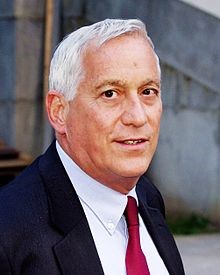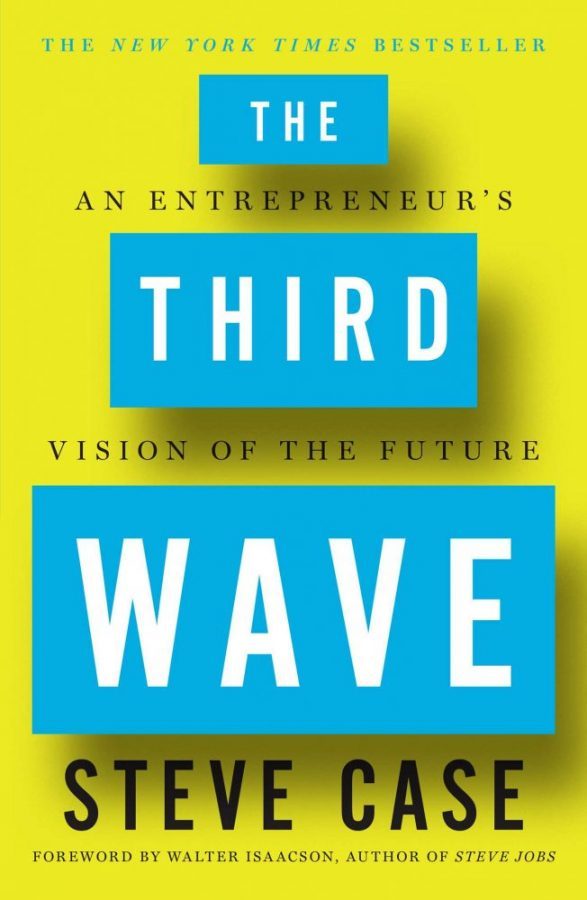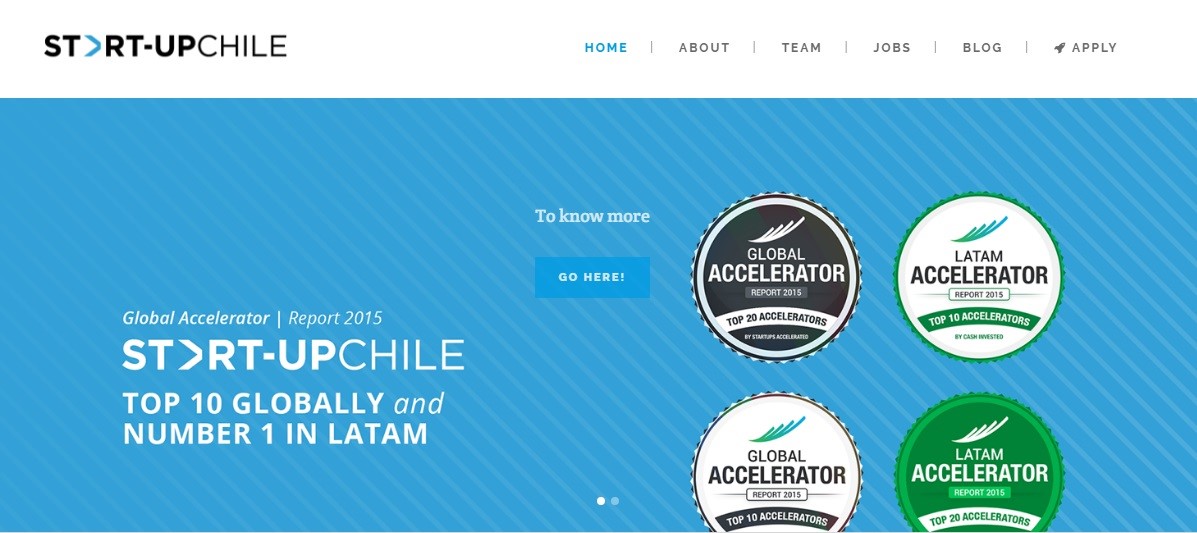BOOK REVIEW: “The Third Wave – An Entrepreneur’s Vision of the Future” by Steve Case
When Steve Case’s book came out on 5 April 2016 (publisher: Simon & Schuster), it was an immediate New York Times and Wall Street Journal sensation, hailed as the number one business book of the year.
Part memoir, part business manual, it’s a must read for at least two reasons:
- one, because it is a unique memoir from someone who was on the leading edge of the Internet revolution: Steve Case was a co-founder of AOL in 1985, the first Internet company to go public (in 1991), the first to bring millions of Americans online; AOL was a corporate giant that arose a full decade before Google, Amazon and Facebook; Case oversaw the Time Warner-AOL merger in 2000 and became chairman of the combined business, the largest media and communications empire in the world at that time.
It is clear that any aspiring entrepreneur could learn from Case’s unique insights into the startup experience, ranging from near death to unexpected comebacks; and, cherry on the cake, the book comes with a mesmerizing series of photographs marking the main events in Case’s life and AOL’s rise.
- two, it provides an eye-opening vision of the Internet’s future: if anyone has an idea where the Web is headed, surely Steve Case does. In the words of Sheryl Sandberg, Facebook’s COO, he has drawn a “compelling roadmap for the future”. No entrepreneur or corporate manager who wishes to succeed in this first part of the 21st century can afford to ignore Case’s advice.
What is remarkable about Steve Case is that he is both an inspired investor and a dedicated philanthropist.
In the Photo: Steve Case Photo Credit: Twitter
Six years before leaving AOL-Time Warner in 2003, Steve Case had launched the Case Foundation with his wife Jean and had made it his business to bet on upcoming innovative entrepreneurs, keeping himself abreast of all new developments in the IT world.
In 2005, he co-founded, along with Donn Davis and Tige Savage, an investment firm aptly called Revolution to finance digital startups, aiming, according to its website, to “support ideas that change the world.” Based in Washington D.C., the firm, of which he is chairman and CEO, also runs a $525 million fund to invest “outside of Silicon Valley” – in fact, as explained on its website, Revolution’s “mission is to establish itself as “the premier firm outside Silicon Valley.”
Revolution has helped build up many businesses including the car-sharing app Zipcar, the GPS fitness tracking app Runkeeper, the online learning platform BenchPrep, the daily deal website LivingSocial, Sweetgreen, an American “simple, healthy food” restaurant chain and Revolution Money, an online financial services company (sold to American Express in 2009) .

In the Photo: Sweetgreen launch Photo Credit: Revolution
In 2010, Steve and Jean Case took the further public step of signing The Giving Pledge, joining other major billionaires like Bill and Melinda Gates, Warren Buffet and Carl Icahn, in reaffirming their commitment to give away most of their wealth to philanthropy.
At the same time, Case is a rare believer in a bi-partisan approach to economic policies.
Though a Republican, he has worked to support President Obama’s job policies to create employment and spur entrepreneurship. He was a member of Obama’s Council on Jobs and Competitiveness and founding chair of the Startup America Partnership – he is now chairman of UP Global, a non-profit to support entrepreneurial communities, created in 2013 from Startup America Partnership and Startup Weekend. Unlike many in the business community, he strongly believes that the government has a key role to play in jump starting innovation.
The foreword is written by Walter Isaacson, President and CEO of the Aspen Institute and author of several acclaimed biographies, most recently of Steve Jobs and of a remarkable history of innovation on the Web called “The Innovators: How a Group of Inventors, Hackers, Geniuses, and Geeks Created the Digital Revolution.“

In the Photo: Walter Isaacson
Walter Isaacson, in introducing Steve Case for us, evokes the moment when the idea of a Time Warner-AOL merger was first aired out, back in 1999. It happened improbably in Beijing, in the course of a twelve-course banquet for a thousand people at the Great Hall of the People to celebrate the 50th anniversary of the Communist revolution in China. Time magazine, of which Isaacson was editor at the time, had brought to China the whole of the Time Warner Board and a few other American business leaders, notably Steve Case.
On that occasion, Isaacson was struck by Steve Case’s “placid face but intense eyes” and the casual way Case chatted with Time Warner CEO Jerry Levin and Vice Chairman Turner. Whether casual or not, four months later, in 2000, the AOL-Time Warner merger had been completed. Wall Street enthused. AOL, that had been valued at just $70 million when it had gone public eight years before, suddenly reached the extraordinary valuation of $160 billion, making it one of the most valuable corporations in America at the time.
The book shines a light on one of the great mysteries of the AOL-Time Warner merger: it should have been a “marriage made in heaven” yet, contrary to expectations, it turned into a disastrous divorce hurting all involved, including Steve Case. From the first, he was set aside, forced to take on the (largely honorific) position of Chairman. As he recounts it, he tried several times to turn the situation around, but his efforts floundered on the staunchly traditional publishing culture of Time Warner, totally closed to the potential of the online market; eventually, he left and started a new chapter in his life as a venture capitalist and philanthropist.
Armed with such a life experience, Case has a lot to say about the present and future development of the Internet, which he defines as the “third wave” and which, according to him, is already upon us.
The term “third wave” as he uses it does not mean the same thing as Alvin Toffler did in his 1970s futurology bestseller also entitled “The Third Wave.” In that book, human history was classified in three phases, first agriculture, then industrialization, and finally the rise of the Web as a third “wave.” Incidentally, in case you’re wondering, Case has every right to use the same title as Toffler: a book title cannot be copyrighted; and by picking the same title, he wanted to mark his appreciation for Toffler’s book that had been his favorite in college, to learn more about copyrights, there are some copywriting lessons you can take online.
What Steve Case means in his book is that the Internet has now entered a third phase.
With the advent of the Internet of Things, it’s going to be radically different from the second phase that saw the rise of giants like Amazon and Facebook and a raft of apps, from Snapchat to Instagram, from Uber to Airbnb. In fact, Case argues, the “third wave” in many ways, is going to present challenges that are much closer to those that characterized the first phase of the Web – when he started AOL.
The Three Waves of the Internet
Here is how he sees it:
- The First Wave was about building the Internet structure, working on “the hardware, software and networks”; the big players at the time were the likes of Microsoft, Apple, IBM and of course Steve Case’s own AOL, building together “the on-ramps to the information superhighway”; in the early days, it was very hard to get people online, it required a lot of explanation – but finally it worked, in large part thanks to AOL’s savvy marketing (at one point AOL accounted for 50% of all the online traffic) and the stage was set for the next wave;
- The Second Wave was about “building on top of the Internet” and, as Case poetically put it, “getting people online gave the next generation of innovators a new canvas and new paint”; Google made it easy to search for information, Amazon and eBay “turned their corner of the Internet into a one-stop shop”; social networking “came of age”; a mobile age was started with Apple’s i-phone and Google’s Android;
- The Third Wave is now impinging on the second wave, for the first time linking the digital and real world tightly together and the “Internet stops belonging to Internet companies.” Case argues that the concept of the Internet of Things (sensors on products connecting them to each other and smartphones) is too limited: “what’s emerging is the much broader Internet of Everything.”
Related article: “THE SECRET TO DRIVING CUSTOMER ENGAGEMENT“
Steve Case’s big insight: The Internet of Everything
What it means is that Third Wave entrepreneurs will “play” with the whole of the economy: to break into industrial ecosystems and social services, they will have to build partnerships both in the private sector and in government. Indeed, they will have to “navigate a policy landscape that most Second Wave companies could ignore.”
To succeed in the brave new digital world, Third Wave entrepreneurs will have to weave agreements with policy regulators and surmount obstacles and barriers to entry the likes of which Second Wave entrepreneurs never had to face (they could largely “play on their own”).
This was especially true of Second Wave companies like Twitter and Instagram that operate exclusively on the Internet. But those linking to the real world with their apps, like Uber and AirBnB, are fast learning that they can’t afford to ignore the “policy landscape” – things like taxi driver union rules and city regulations. In that sense, they are already Third Wave companies, they arguably stand on the borderline between the Second and Third Waves. This in no way diminishes Case’s argument: someone will always be borderline, linking the past with the future. As Case notes at the end of his book, Uber got into trouble as soon as their strategy took them beyond the local level: They found themselves challenged by lawsuits in a dozen states in the US and abroad.
The central thesis of the book is this: “the lessons from the First Wave will be integral to the Third.”
The rules of the entrepreneurial game are back to what they were in the First Wave when entrepreneurs had to spend “a great deal of time focused on things other than tech” because what they needed above all was a strategy to break down skepticism and find ways to bring people online.
In the same way, Third Wave entrepreneurs will need to build Internet connections in “skeptical industries with powerful gatekeepers.” They will “challenge the biggest industries in the world” and Case lists health care, education, transportation, food and finance as the future areas of digital battles.
The “3 C’s” of the Third Wave: Entrepreneurs will learn that they cannot just focus on “content” as Second Wave entrepreneurs did, but that they will need to take into account the “3 C’s”: content, context and community, just as Steve Case had to do at AOL back in the 1990s.
According to Case, the “superstars of the Third Wave will pursue bold visions, but their true gift will be mastery of execution”. And that “mastery” will be grounded in the “three P’s: partnership, policy and perseverance”. Third Wave companies will need leaders who not only never give up but who are capable of “forging solid partnerships with key players in the real world.”
To illustrate this fundamental point, Case brings a lot of examples in his book drawn from his own experience and from others, but here one will suffice: In the field of higher education, MOOCs (massive open online courses) failed as long as they took the established universities head on. But, observes Case, they succeeded as soon as they built partnerships; for example, Coursera, one of the leading MOOC companies got the former president of Yale as CEO.
That’s a powerful insight. And it means that Third Wave entrepreneurs are less likely to be “20-something computer coders” and more probably “30-something farmers and factory workers and chefs and artists – people who saw a problem in their own sphere of expertise” and were able to use “the skills of others” to build their company.
How the Third Wave will be Different from the Past
But there are other great insights in this book about how our digital economy will change.
- “The Rise of the Rest”
This is a phrase coined by journalist Fareed Zakaria in 2008 to describe what is happening in China and India.
Photo: At the Davos forum in 2006, Fareed Zakaria is second from right, Photo Credit: World Economic Forum/ Peter Klaunzer
Steve Case sees the same happening within the United States, as Silicon Valley’s primacy gives way to the “rest” of the country.
The reason for this is straightforward: for Third Wave entrepreneurs, it makes sense to deal directly with the experts of the industries they want to “disrupt” or infiltrate. Case sees this as ultimately “bringing diversity”; the leaders of emerging companies are likely to be the most “diverse group of CEOs America has ever produced”.
But he worries that America might lose its digital primacy in the world.
The rise of the rest is obviously a two-edged sword and American entrepreneurship will surely be put to the test. No doubt this is why he has been involved in fostering “regional entrepreneurship.”
- Impact Investing
This is another one of Case’s notable insights. He defines impact investing as “a bridge between traditional business and philanthropy – and between financial return and social good”, noting that it is driven by the preferences of the millennial generation and supported by recent government policies, in particular the Social Impact Investment Taskforce created by the governments of the G8 in 2013 (the “invisible heart of markets“). Laws were passed in dozens of states in the US creating benefit corporations, or B corporations. By 2015, there were more than 1,500 such corporations, among them Kickstarter, Warby Parker, Patagonia and Etsy, all with purpose and impact explicitly built into their corporate charters.
Impact investing reinforces the Third Wave. And Case has joined the battle with his Case Foundation, becoming a prime “impact investor.” He sees a big future in it, citing one projection that suggests that impact investing will rise twenty-fold by 2020, to more than $1 trillion.
- The Case for Strong Government Support
This is perhaps surprising for a Republican but Steve Case is not mincing his words:
Government is going to be central to the Third Wave. Full stop.
He recalls how ARPA (Advanced Research Projects Agency) created by President Eisenhower in 1958 (later, as the Cold War grew colder, it became DARPA, the D is for Defense) played a critical role in the development of the Internet, and consequently, was part of AOL’s rise; how the Government’s Digital Libraries Initiative (DLI) research grants between 1994 and 1999 helped two Stanford graduate students Larry Page and Sergey Brin in founding Google.
Photo: DARPA homepage
Case sees two key roles for Government: As a regulator (cyber security will be high on the list) and as a customer.
He describes in detail his own willingness to work with government, most recently as Chairman of Startup America and joining the President’s Council on Jobs and Competitiveness (Jobs Council). He is also concerned with updating immigration laws to ensure that the US is “better positioned to win what has become a global battle for talent.”
He takes on the notoriously conservative Silicon Valley mogul Peter Thiel in a subtle way, saying:
Here’s what people like Thiel get right: Government is slow. It is frustrating. It is dysfunctional. […] But the Valley is wrong to view government as the enemy. It’s wrong to measure government the same way it measures businesses. They exist in fundamentally different sectors, working with different rules, executing against different missions. […] And when [the government] can help, and where it can help, it can do so on a scale that no private company or nonprofit organization can contemplate.
A Road Map for the Future
The book ends on a chapter mapping what the United States should do to “prevent the future,” in the sense of ensuring that Third Wave companies do not go abroad but start on American soil and choose to find success here. And there is a good reason for this:
- Startups, and not small businesses as is commonly thought, create most “new net jobs” in the United States.
This is a little-known fact and Case spends time on this, citing a recent Kauffman Foundation study that shows that the top-performing one percent of startups – often called “gazelles” – are responsible for some 40% of new jobs each year. Policymakers, take note!
Indeed, Case calls on the government to “get in front of the Third Wave,” providing some excellent pointers for institutional reform. Among the more attractive temporary fixes he proposes, there is the idea of a “Third Wave czar,” someone with knowledge and authority who would be appointed by the President to work across all Federal agencies concerned and report directly to him, the way it was done to handle the Ebola crisis.
- The Federal Government should raise its spending on R&D; the flow of investments into startups should be supported; hiring top talent should be made easy.
This is how Case sees the role of the Federal government. He is deeply concerned that Federal spending is at the lowest level (0.69% of GDP) since the 1950s and he lists a number of agencies and programs that should be bolstered. He is also worried that it is becoming harder to hire top talent.
He reminds us of the ways Congress could help – including fiscal incentives and reforming immigration rules and creating a Startup Visa Program, to welcome immigrant entrepreneurs in the United States. He is a profoundly patriotic American but he also believes that there are “many, many immigrants with good ideas.” He cites a 2012 Kauffman Foundation report that found that about one in four tech companies established between 2006 and 2012 had at least one foreign-born founder, and in Silicon Valley, half of them did. Famously, Elon Musk came from South Africa and Sergey Brin from the Soviet Union.
But the nightmare of obtaining a green card is turning away talented people from the United States. Case argues that the pool of H-1B visas is too small in relation to demand: the number was capped at 140,000 a year in 1990 and that number hasn’t changed since: Compare this to the 172,000 petitions sent in 2014 to the US Citizen and Immigration Services and you’ll see the magnitude of the problem.
- There is a need to “write new rules for a new era.”
Uber and Instacart are upending our views on employment and what it means to be a worker; in Case’s view, protective unemployment and health insurance and vacation and retirement benefits should be rethought and regulated to adapt to this new “freelance” or “sharing” economy.
- “Time is not on our side.”
This is a warning Case repeats throughout the book. He points to Canada launching its own Start-up Visa Program in 2013, Chile’s flagship “Start-up Chile” in 2010, and notes that London “leapfrogged” San Francisco and New York as the world’s top city for crowdfunding in 2013.
Photo: Startup Chile Home Page
In short, all regions in the world are getting on board, while “America is trending sideways,” as Case puts it. He feels strongly that America can and “should lead in the Third Wave.”
For those who like to bypass details and focus on the “meat”, Steve Case offers a last chapter that neatly summarizes his thesis (Chapter 12). Here the advice is specifically directed to entrepreneurs, corporate America and the government. He ends on a special “message for you” based on his own experience, saying to the reader:
It was my great fortune to help get America online. It’s up to you to get America – and the world – on track, to lead the Third Wave and beyond. […] This moment should speak to the innovator inside you. […] Take action. Be fearless. You may stumble, but get back up. Keep going. […] Topple an empire and build your own from the ground up.
Strong, inspiring words – a message that permeates the book. Beyond the message, there are deep insights into the future of the digital revolution, where it is headed and why, that make the book a must read for entrepreneurs and would-be entrepreneurs but also for policy-makers, venture capitalists and corporate managers to inform their decision-making.
As Steve Case never tires to remind us, the race is on, let’s not miss out on the future.
Recommended reading: “STEVE CASE: THE ‘THIRD WAVE’ OF THE INTERNET WILL TRANSFORM OUR INSTITUTIONS“
_ _













